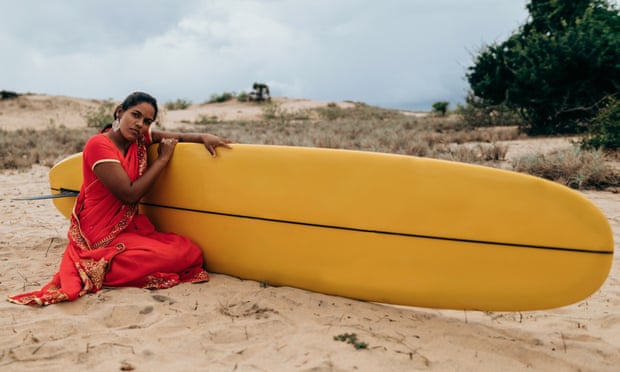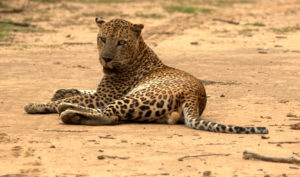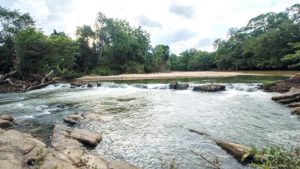FEATURES
Published 1 day ago
on 2022/04/24

by Dianthi S.U. Wijeratne
The following morning we left for Gal Oya from Arugam Bay through Siyambalanduwa. While traveling we saw Govinda Hela, a mountain which the British called Westminster Abbey. Further away was another mountain, known as Vadinagala, which was seen even from the campsite in Gal Oya National Park.
After a drive through scenic country, we arrived at Inginiyagala in the Gal Oya valley. Here we stopped to have a look at Senanayake Samudra. The meaning of Samudra is “sea”. It most probably would have looked like a sea had it been full of water. Unfortunately the water level was well below average due to the drought that was prevailing at the time. Most of the rocks at the bottom of the tank too were exposed.
I have seen pictures of myself as a small child going with my parents and brother in a launch on Senanayake Samudra. I have my doubts that this facility is still available considering the security factor. This has been the first reservoir to be built after independence by D.S.Senanayake, the first Prime Minister of the country.
The vegetation within the park was quite green unlike that in Yala, Udawalawe and Kumana. One reason for this greenery may be the availability of water in Senanayake Samudra, which is in the centre of the park. The place was quite damp and cool.
In all probability there was only one motorable road within the park and there were no bungalows. After a drive of about two miles, we reached the campsite. While we were relaxing at the campsite I spotted two elephants with two babies in the far distance. After a short while we proceeded to Ampara. The heat was unbearable as it was 38 degrees C. On the way to Akkaraipattu we visited Deegavapiya Chaitya, which is said to have been built by King Saddhatissa 400 years after Lord Buddha’s demise.
In Sri Lanka there are supposed to be six medicinal troughs (beheth oruwa). A cavity in the shape of a human being is carved out of one piece of solid rock. In ancient times this cavity was filled with medicinal fluids, such as oils, milk and herbal mixtures, and the patient was immersed in it. One of the oldest medicinal troughs had been found in Deegavapiya.
My father was very keen on seeing it, but what we saw was something we never expected. It was lying as a heap of broken stone fragments in a corner of the temple. According to the chief monk, this trough was located about a quarter mile from the temple, and he had decided to relocate it in the museum at the temple premises. He had been in the process of getting ready to have it transported, when this historical piece of artwork had been blasted into several pieces with the use of explosives by some persons, whose identity was known to him.
We came back to Arugam Bay via Akkaraipattu, and on the way we passed through Sinharamuthuvaran, where a very attractive cadjan-roofed resthouse once stood, as well as Komari of Kavantissa fame. We returned to Colombo the next day.

Yala Block two
Block two of the Ruhuna National Park, which was seen across Kumbukkan Oya at Kumana, could be entered from Yala. I remember travelling this way in May 1992. When our Land Rover was being taken across Menik Ganga at Nana Thotupola, the vehicle stalled in the middle of the river due to its wheels getting stuck in the sand. Every effort was made to pull it out the vehicle with the help of the accompanying four-wheel drive pick-up,’ as well as that of about 25 men who were bathing in the river at the time, but to no avail.
Finally success was achieved with the help of the Land Rover’s winch, which was hooked on to the back of the stationary pick-up. Having thus entered Block two, we then proceeded a short distance till we came to Katupila Ara, which too had to be forded. I remember my brother-in-law wading across to check the path the vehicles should take.
Having safely crossed over, we came across a small water-hole where we saw a remarkable sight which was never before witnessed by any of us present. Though there were people in the party who were highly experienced in the ways of the jungle, this sight was unique to them too. There were over a hundred crocodiles of all sizes sun bathing all round the water-hole. They all crawled hurriedly into the water on the approach of the vehicle, and there was not even a ripple on the surface of the water to show that there were so many crocodiles in that small water-hole.
If a small animal, such as a deer, ventured there for a sip of water it would no doubt have been an easy prey. Having witnessed this scene, we realized that my brother-in-law had faced much danger from crocodiles in wading across Katupila Ara.
Further on, we came to Pottana where we saw a fresh water well built with masonry. It was an unusual sight in a jungle without human habitation. My father told us that it was a well that was built for the use of pilgrims on their way to Kataragama from Potuvil. This has been the path where a man-eating leopard had been lying in wait many years ago to attack sick and decrepit pilgrims.
In 2002 we repeated the trip. The water level in Menik Ganga was quite low and it was smooth sailing for the three pick-ups to cross over to the other side. On this occasion no one dared to test Katupila Ara before the vehicles crossed. The water was almost up to the bonnets and the windscreens did get washed in the process. We saw a huge bull elephant and a lot of buffalo grazing not too far from us. The road to Pottana was really bad. At a certain point I thought that each vehicle would topple on to its side.
Pottana Pitiya was a vast dry plain with thin vegetation. Beyond this was the lagoon and then the sea. We met a couple of visitors with a tracker cooking their lunch near the sea. They were kind enough to offer us some fried prawns as a snack. Unlike on the previous occasion we did not come across the small water-holes or the well of fresh water. Most probably we would have taken a parallel route.
On our return journey, we found that the water level in Katupila Ara was higher than in the morning. We crossed it with difficulty, the engine just escaping being flooded by the depth of water. On the other side of the Ara, we found a jeep which had been immobilized by water getting into the engine.
They had brought a mechanic from Tissamaharama to repair it. It was quite late in the evening and there was no sign of getting the engine started. Later we heard that the jeep had been towed the next morning for a major repair.
It was late in the evening when we reached Menik Ganga. We were so glad to see Block two after a lapse of 10 years.
In February 2004, while camping at Yala, we once again entered Block two. Proceeding northwards, we forded Katupila Ara, Pottana Ara and finally the broad Kumbukkan Oya, to reach Kumana. After visiting Kumana villu, we returned to Yala the same evening. It was a memorable journey, having passed through perhaps the most extensive plains I have seen.
Yala Blocks three, four and five
The North Intermediate Zone was absorbed into the Ruhuna National Park. This step was taken when the government in 1964 banned the issue of licenses to shoot animals, thereby making the presence of Intermediate Zones where shooting was allowed, meaningless. This annexure was divided into Blocks three, four and five. The Department of Wildlife Conservation built a bungalow in Dambakotte in Block four, which was reached by travelling along the Buttala – Kataragama highway.
We left Colombo on December 21, 1996 and reached Dambakotte bungalow, where we were to stay three nights. The bungalow, which was about a kilometre from the road, was surrounded by tall jungle trees, while underneath them was a carpet of beautiful grass which was of a special green. About a kilometre further into the jungle was a tank, which we visited several times during our stay, but failed to see any significant wildlife except several varieties of water birds.
This area was said to be rich in bear population though we did not see any. However, we heard the loud mating call of a bear quite close to the bungalow at about 11 o’clock in the night. The noise faded away into the distance in a few minutes.
Block 3
We traveled to Galge, which was about five km from Dambakotte. About 200 yards away from the quarters and offices of the Department of Wildlife Conservation was an extensive slab of rock where there was a large natural water-hole or kema, which probably never ran dry during the drought. The employees used to draw their regular supply of water from this water-hole. On our way to this water-hole, a large wild boar accompanied us, and we thought it was a pet of the men working there. Little did we realize the danger we were in till we were told that it had attacked a police inspector a few days earlier and he was still being treated in hospital at the time.
The water-hole had caved into the rock sideways to form a very large cavity, while the opening into the exterior remained comparatively small. By these means only a small area of water was exposed to the sun, thereby reducing the amount of water that would evaporate. This contrivance probably accounted for the failure of the drought to dry the water-hole.
The impressive Ireson tower stood on a rock some distance from the water-hole. We reached it by shuffling along the narrow stony ledge of the water-hole with difficulty. This tower was an outstanding memorial to J P Ireson, who died of diarrhoea in 1922 at Monaragala, where he was planting. He was president of the Wildlife Society at the time, and it built this memorial to him at Galge, which could only be reached on foot or horseback at the time.
Ireson was an inveterate hunter, who used to come down frequently from Monaragala to hunt around Galge, which therefore was selected as the site for the memorial. However, on questioning the average man there, the answer would invariably be that it was a monument to an Englishman killed by an elephant at that spot.
From Galge we went through thick jungle, along the only available jeep track in Block three. In view of the many obstacles that greeted us, this track had not been used for a long time. We reached a large rock known as Paskema (five water-holes). Its surface had several water-holes of different sizes, some with beautiful lotus flowers, but it probably received its name from the fact that there were five significant water-holes in it. On climbing the rock we could see the jungle far and wide, the trees being festooned with flowers, young leaves turning crimson and woody creepers hanging heavily on branches.
Malwarikema
Continuing the journey, we came to Malwariweva which was a tank that had been renovated a short time earlier. We walked along the bund and saw pits on it which were produced by elephants whose feet had sunken into the earth as they descended into the water.
Further on, we came to Malwarikema that had, as its name implied, a water-hole which appeared beautiful with blossoming lotus. This was apparently an old monastic site. An unusual finding on it was the presence of two cone-shaped pits, several yards apart from each other. Each measured about eight inches in diameter and six inches in depth, and they were exactly circular and the walls perfectly smooth. The tracker who accompanied us explained that they were pits in which treasures were hidden in the olden days, and that treasure hunters had raided them and removed the contents.
It was difficult to believe this story. The pits were not large enough to hide such treasures, and it was unlikely that rainwater would be prevented from seeping in. It is a moot point how treasure hunters would have located them once the contents had been sealed off by the owners centuries ago.
Block five
The Buttala – Kataragama highway does not exactly follow the old jeep track, as it deviated about a hundred yards at certain points. The jungle that lies between this highway and the Menik Ganga is Block five. We had a bath in the river at a place at which two tributaries joined to form the main river. This was the point at which the elephants from Handapangala crossed the river when they were driven into Block four by the Department of Wildlife Conservation. The wisdom of this man oeuvre is open to question, for several elephants died subsequently.
Indikolaweva was a tank in Block five which had been recently renovated. On the bund was an elongated piece of dung, which the tracker identified as that of a crocodile. He mentioned that it was rather poisonous to the skin, for blisters may form when trod on. On the other side of the long bund, we saw an elephant, while a tall tree nearby was crowded with hornbills. We did not see any other animals of significance, and this was true of all these Blocks. One reason for this scarcity of animals was probably the presence of tall jungle trees in the areas we visited.
(concluded)
(Excerpted from Jungle Journeys in Sri Lanka edited by CG Uragoda)
























 Arugam Forum
Arugam Forum Arugam Photo Galleries on Picasa
Arugam Photo Galleries on Picasa Old Website
Old Website Press Coverage
Press Coverage Surf Forecast for Arugam Bay
Surf Forecast for Arugam Bay
TODAY’s Comments